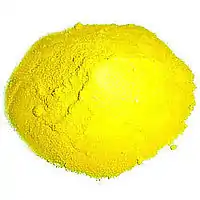Calcium chromate
Calcium chromate is an inorganic compound with the formula CaCrO4, i.e. the chromate salt of calcium. It is a bright yellow solid which is normally found in the dihydrate form CaCrO4·2H2O. A very rare anhydrous mineral form exists in nature, which is known as chromatite.[1]
 Anhydrous calcium chromate | |
 Calcium chromate pigment | |
| Names | |
|---|---|
| IUPAC name
Calcium dioxido-dioxo-chromium | |
| Other names
Calcium chromate (VI) Calcium monochromate Calcium Chrome Yellow C. I. Pigment Yellow 33 Gelbin Yellow Ultramarine | |
| Identifiers | |
3D model (JSmol) |
|
| ChemSpider | |
| ECHA InfoCard | 100.033.955 |
| EC Number |
|
PubChem CID |
|
| RTECS number |
|
| UNII | |
CompTox Dashboard (EPA) |
|
| |
| |
| Properties | |
| CaCrO4 | |
| Molar mass | 156.072 g/mol |
| Appearance | bright yellow powder |
| Density | 3.12 g/cm3 |
| Melting point | 2,710 °C (4,910 °F; 2,980 K) |
| anhydrous 4.5 g/100 mL (0 °C) 2.25 g/100 mL (20 °C) dihydrate 16.3 g/100mL (20 °C) 18.2 g/100mL (40 °C) | |
| Solubility | soluble in acid practically insoluble in alcohol |
| Structure | |
| monoclinic | |
| Related compounds | |
Other anions |
Calcium dichromate |
Other cations |
Beryllium chromate Magnesium chromate Strontium chromate Barium chromate Radium chromate |
| Hazards | |
| Occupational safety and health (OHS/OSH): | |
Main hazards |
highly toxic, carcinogen, mutagen |
| NFPA 704 (fire diamond) | |
Except where otherwise noted, data are given for materials in their standard state (at 25 °C [77 °F], 100 kPa).
Infobox references | |
The compound is occasionally used as a pigment, but this usage is limited due to the very toxic and carcinogenic nature of hexavalent chromium compounds such as chromate salts.
Synthesis and reactions
Calcium chromate is formed from the salt metathesis reaction of sodium chromate and calcium chloride:
- Na2CrO4 + CaCl2 → CaCrO4 + 2 NaCl
In aqueous solution the dihydrate is obtained, which loses water to afford the anhydrate at 200 °C.
It is an oxidiser, oxidising organic compounds (e.g. alcohols) or reducing agents (e.g. metals) to the corresponding carbonyl compounds or metal oxides while the chromium(VI) centre in CaCrO4 is reduced to chromium(III).
Solid calcium chromate will react explosively with hydrazine. It will also burn violently if mixed with boron and ignited, thereby posing a fire hazard.[2]
Uses
The compound is occasionally used as a yellow inorganic pigment, or a corrosion inhibitor as part of the chromate conversion coating procedure.
It has been also utilised in chromium electroplating, in photochemical processing, and as an industrial waste treatment.
All applications suffer from the high toxicity of chromium(VI) species to humans, with chromates listed as IARC Group 1 carcinogens while also very corrosive (e.g. capable of producing permanent eye damage) and genotoxic.[3][4]
References
- "Home". mindat.org.
- Occupational Safety And Health Guideline For Calcium Chromate Archived August 8, 2007, at the Wayback Machine
- IARC (2012) [17-24 March 2009]. Volume 100C: Arsenic, Metals, Fibres, and Dusts (PDF). Lyon: International Agency for Research on Cancer. ISBN 978-92-832-0135-9. Archived from the original (PDF) on 2020-03-17. Retrieved 2020-01-05.
There is sufficient evidence in humans for the carcinogenicity of chromium (VI) compounds. Chromium (VI) compounds cause cancer of the lung. Also positive associations have been observed between exposure to Chromium (VI) compounds and cancer of the nose and nasal sinuses. There is sufficient evidence in experimental animals for the carcinogenicity of chromium (VI) compounds. Chromium (VI) compounds are carcinogenic to humans (Group 1).
- "Calcium chromate 10827-V". ntp.niehs.nih.gov. National Toxicology Program (United States Department of Health and Human Services). Retrieved 2021-03-30.
